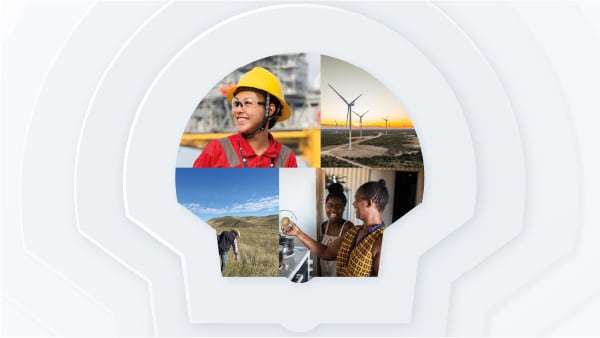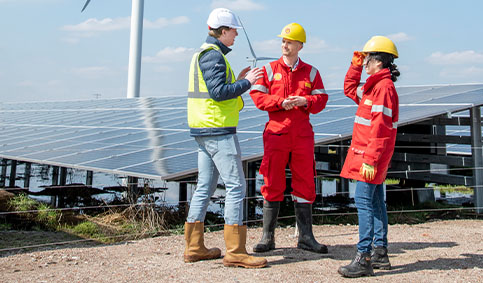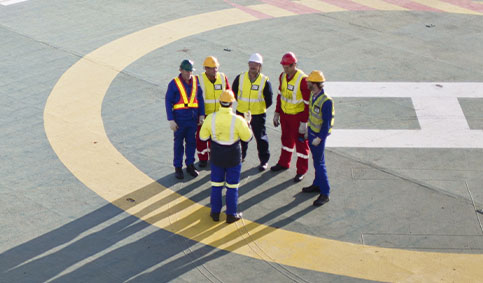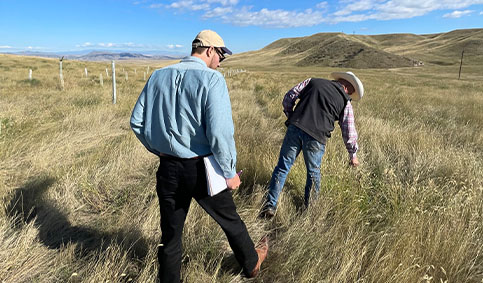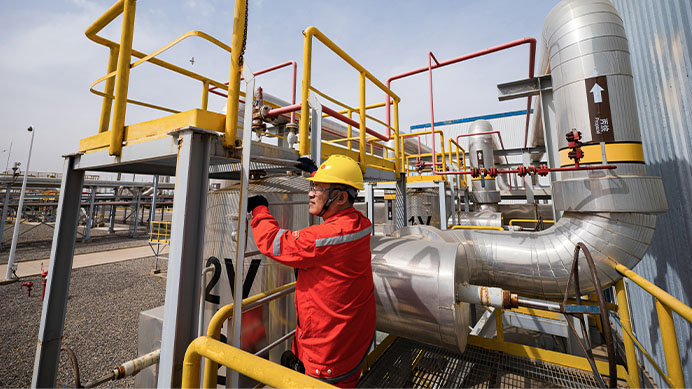Producing oil and natural gas
Oil and gas will continue to play a crucial role in the energy system for several decades to come, with demand decreasing gradually over time. To maintain the secure supply of energy on which society relies, it is vital that the world does not dismantle the current energy system faster than it can build the energy system of the future.
Shell is investing in both low-carbon energy and oil and gas in a disciplined way, while finding sustainable and profitable ways to create value and transition to net zero.
We continue to make progress in reducing the greenhouse gas emissions from our oil and gas operations. In 2023, we implemented projects to reduce flaring at our Pearl GTL gas-to-liquids facility in Qatar, increase electrification of our sites in Canada and the Netherlands, and vent less methane at our QGC facility in Australia.
Read more about our approach at www.shell.com/what-we-do/oil-and-natural-gas and in our 2023 Annual Report.
Liquefied natural gas
Shell is a leading liquefied natural gas (LNG) supplier with diverse sources of LNG from different regions, alongside extensive shipping and storage assets and access to regasification plants.
LNG serves both energy security and the energy transition. Natural gas generates electricity, heating and cooling for industries, homes and businesses, and it provides grid stability and flexibility which enable continued growth for wind and solar energy in power generation.
LNG plays an important role in hard-to-electrify sectors like shipping and heavy-duty road transport, where it can reduce greenhouse gas emissions by up to 23% and 22% respectively from production to use compared with conventional fuels.
As one of the world’s largest suppliers of LNG, we are able to ship natural gas to where it is needed most.
Shell has access to almost 40 million tonnes of capacity through its interests in 11 liquefaction plants. We are growing our portfolio by a third with around 11 million tonnes a year of new LNG capacity under construction, which will come on stream in the second half of this decade.
We are also working with our joint-venture partners to reduce the emissions intensity of our LNG projects. LNG Canada (Shell interest 40%), which is expected to start production later this decade, is designed to have the lowest carbon intensity of any large liquefaction facility currently operating anywhere in the world ― about 60% lower than the average facility today and 35% lower than the best-performing facility.
We are partners in the North Field East and North Field South expansion projects in Qatar which will supply markets worldwide and include carbon capture and storage to reduce emissions.
Read more about liquefied natural gas at www.shell.com/what-we-do/oil-and-natural-gas/liquefied-natural-gas-lng..
Conventional oil and gas
We have conventional oil and gas operations in 15 countries, onshore and offshore, at various stages of the life cycle and with varying degrees of size and complexity. Our Upstream business aims to keep liquids production (crude oil and natural gas liquids) levels flat, while delivering lower-carbon oil.
In 2023, we delivered first gas from the Timi unmanned platform (Shell interest 75%) off the coast of Sarawak in Malaysia. Timi is powered by wind and solar energy and is around 60% lighter than a conventional wellhead platform powered by oil and gas.
Read more about our approach at www.shell.com/what-we-do/oil-and-natural-gas.
Deep water
Shell has a long history of using its knowledge, experience and proven deep-water technologies to unlock energy resources safely and efficiently.
In the US Gulf of Mexico, we are the leading operator and have one of the lowest greenhouse gas intensities in the world for producing oil, compared with other oil and gas producing members of the International Association of Oil & Gas Producers. Our latest Shell-operated development, Vito (Shell interest 63.1%), started production in 2023. Vito is a third the size of its original design, which is expected to reduce CO2 emissions by around 80% over its operating life. We are using the same design concept for our Shell-operated Whale facility (Shell interest 60%) and Sparta project (Shell interest 51%) in the US Gulf of Mexico, which are expected to start production in late 2024 and 2028 respectively. Sparta will also feature all-electric topside compression equipment, significantly reducing greenhouse gas intensity and emissions from our own operations.
Read more about Shell’s deep-water operations around the world at www.shell.com/what-we-do/oil-and-natural-gas/deep-water.
Shale oil and gas
Following the divestment of our Permian business in the USA in 2021, we have limited involvement in shale oil and gas production. We have shale production interests in Argentina and Canada.
Read more about shale oil and gas production at www.shell.com/what-we-do/oil-and-natural-gas/shale-oil-and-gas.
Arctic
We do not plan to pursue new frontier oil exploration leases in the Arctic.
Shell ended offshore exploration drilling operations in Alaska in 2015. We hold one licence interest in the North Slope area of Alaska. We also hold several licences from our previous activities in the Canadian Arctic, although we do not plan to develop these licences.
In Norway, Shell is a 10% partner in Irpa, an offshore natural gas discovery in the Norwegian Sea, which is ice-free all year round.
For more information visit www.shell.com/what-we-do/oil-and-natural-gas/exploration/arctic-regions.


